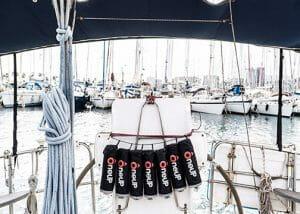 OneUp Launches the World’s Most Compact Self-Activating Life Float – Compact Carrier Case Transforms into Life Preserver with a Single Toss and Contact with Water
OneUp Launches the World’s Most Compact Self-Activating Life Float – Compact Carrier Case Transforms into Life Preserver with a Single Toss and Contact with Water
Canary Islands – April 4, 2018 – According to the World Health Organization, on a global scale, drowning is the 3rd leading cause of unintentional death with an estimated toll of 360,000 lives annually or 42 deaths every hour. To help families, fishermen, boat owners, water enthusiasts and first responders stay safe at the beach, lake, ocean or pool, life preservation company OneUp, today unveils its flagship device, aimed to be the solution to improve water safety.
At 20x smaller than standard, bulky flotation devices that are difficult to maneuver when speed is of the essence, OneUp is a compact, soft drink can-shaped tube that explodes into action when it comes into contact with water, self-inflating to become a one size fits all life preserver.
Named as a tribute to classic videogames of the 1980’s, OneUp’s new, “extra life” approach to aquatic safety enables both professional rescuers and recreational water enthusiasts with the ability to save lives without sacrificing time to manually activate a life preserver. Available today for a discounted early bird price of $49 on Indiegogo, the compact, easily stored device provides on-the-go-safety in both salt and fresh water. Simply toss or hand the lightweight tube to a person in need for automatic inflation and assistance as soon as it contacts water.
“Our mission at OneUp is to improve water safety forever, while giving people an easy-to-use tool they can rely on during any water activity,” said Saúl Arteta, CEO of OneUp. “Until now, life preservers have been bulky and difficult to manage. With our new device, people can still enjoy their time on the water and trust that if an issue arises, OneUp is there to save anyone in just seconds.”
Safety with a Single Toss
At the size of 6.8 inches and weighing only 0.8 lbs, the MSDS and CE certified device comes with a waterproof cover to house the life preserver and a carabiner which allows users to clamp the device to bags and belt loops for added portability. When OneUp is needed, the rescuer simply hands or throws the device to the victim preventing tragedy.
The Science Behind Safety
OneUp was designed with the principals of speed and portability allowing for quick action in the event of an emergency. Its ability to self-inflate is made possible by a small salt pod and CO2
inflation sensor that is commonly used in aeronautical and naval security. Upon contact with water, the salt pod dissolves, releasing the spring which activates the rapid release of CO2 causing instant inflation. The entire process from activation to full life preserver takes only two seconds and the device is reusable with just a 60 second reset time. A single OneUp preserver can hold up to 330 lbs of weight.
The OneUp Advantage
With OneUp on hand, water enthusiasts no longer have to worry about being in non-security areas without lifeguards or life preservers nearby. Now, pool goers, boat owners, fisherman and those who enjoy water activities can provide their own security network for themselves and those nearby through individuals owning OneUp. On a larger scale, OneUp has the potential to minimize government costs in rescues and searches. According to the World health Organization, the United States alone accounts $273 million each year in direct and indirect costs related to drowning.
Availability
OneUp is available now for preorder at Indiegogo.com with pricing starting at $49 and shipping slated for summer 2018. For more information, please visit: oneupsaves.com.
About OneUp
OneUp consists of a small team of water-loving individuals with a passion for activities and sports. Their strong experience in business, production, and manufacturing lead to the company’s creation in 2015 where they worked hand-in-hand with world-wide non-profit organizations and collected early innovation awards.
The company’s goal is to globally reduce the amount of annual drownings by spreading awareness and education on the importance and severity of water safety.

